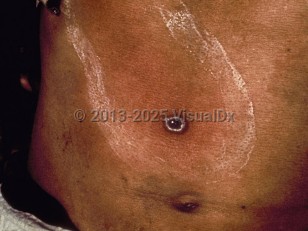Rapid patient isolation, use of personal protective equipment for health care workers, antibiotic delivery, and notification of public health professionals are essential preliminary steps when the disease is suspected. Supportive care in the intensive care unit may be necessary. Patients may require respiratory support and mechanical ventilation as well as fluid resuscitation and blood pressure support.
- Antibiotic treatment should begin as soon as plague is suspected. Pretreatment samples (blood, sputum, lymph node / bubo aspirates) should be collected if possible but should NOT delay treatment.
- Control measures and personal protective equipment for health care workers should be geared toward droplet transmission at a minimum. Consult infection control experts to determine whether additional protection is warranted for caring for patients with potential aerosolizing interventions (eg, high-flow nasal cannula supplemental oxygen delivery).
Infection with the gram-negative bacillus Yersinia pestis, commonly referred to as the plague, is a highly lethal disease that requires rapid, early recognition and prompt treatment. Bubonic plague is the most common form of the disease in humans and is often a consequence of inoculation via a break in the skin. It is characterized by the development of enlarged, painful, draining lymph nodes (called buboes) in conjunction with flu-like symptoms. Bubonic plague may progress to pneumonic and septicemic forms if left untreated. Untreated infections of all variants are highly lethal.
The most common reservoir for Y pestis is rodents (eg, prairie dogs, squirrels, chipmunks, rats), although cases involving dogs and cats have been described as well. The vectors are fleas, which feed on the infected animals and then can transmit the bacteria to susceptible hosts such as humans.
The incubation period for bubonic plague is typically about 4-7 days, and initial symptoms include malaise, myalgias, high fever, headache, and tachycardia. Then the patient will develop large, tender regional lymph nodes called buboes. The inguinal region is the most common site, but buboes can also form in the axillary and cervical lymph node basins. In advanced cases, these lymph nodes can open up and form suppurating wounds.
Untreated, bubonic plague can progress to septicemic and occasionally pneumonic plague in 2-6 days. The mortality rate of untreated bubonic plague can reach 60% or more. However, with treatment, mortality rates drop substantially to approximately 13%. Drug resistance may become an important consideration. Drug-resistant strains of Y pestis have been reported in Madagascar and Tibet.
It is important to recognize that initial symptoms of bubonic plague may resemble a typical cold with lymphadenopathy, and the clinician must have a high index of suspicion based on endemic locations, recent travel, and close contact with rodents or domestic animals that have recently become sick.
Initial diagnosis in the emergency department for a single case may be difficult, unless the link to exposure is readily apparent and there is a readily apparent bubo. Some cases will be diagnosed after admission based on microbiologic culture data or PCR (sputum or blood).
Endemic plague is seen in the western United States (Colorado, New Mexico, Arizona, California, southern Oregon, and Nevada) as well as in central and southern Africa (Democratic Republic of Congo, Uganda, Madagascar), parts of South America (Peru), and central Asia and the Indian subcontinent. The incidence is likely higher than reported given that the majority of cases happen in underdeveloped regions of the world where diagnostic and reporting infrastructures are suboptimal.
People at higher risk for contracting bubonic plague include hunters, hikers, veterinarians, abattoir (slaughterhouse) workers, exotic pet owners, travelers to or residents of endemic areas, and those who live in rat-infested areas.
Rapid patient isolation, use of personal protective equipment for health care workers, antibiotic delivery, and notification of public health professionals are essential early steps when the disease is suspected. If bioterrorism is suspected, the clinician should have a low threshold to activate the hospital incident command system and notify public health authorities.
In a bioterrorism event, intentional release of plague would most likely be in aerosol form, resulting primarily in the highly lethal and contagious pneumonic form of the disease. Bubonic plague could also occur. It is important to have a high index of suspicion for the possibility of a terrorist event when multiple people present with various forms of plague. Also, if someone presents with signs / symptoms suggestive of plague but has none of the expected natural exposures, then public health authorities should be contacted immediately. Once an intentional outbreak is confirmed, all patients with rapidly progressive pneumonia should be considered to have pneumonic plague unless an alternate diagnosis is found. Control measures and personal protective equipment for health care workers should be geared toward droplet transmission at a minimum.



